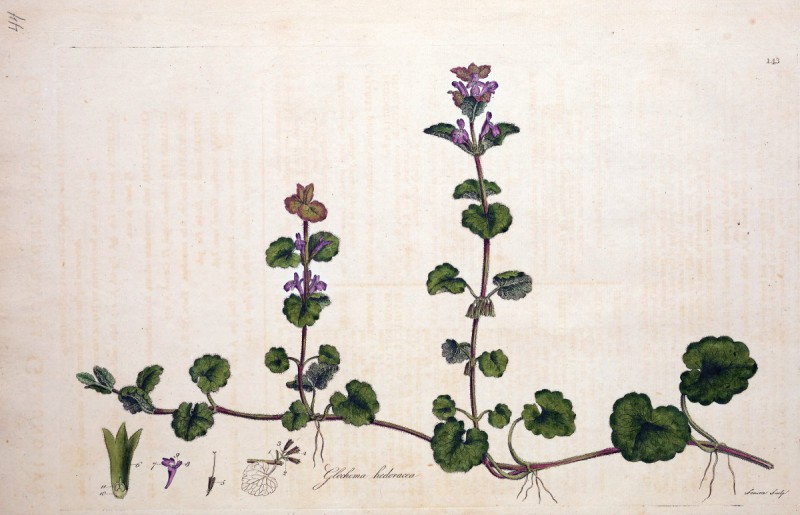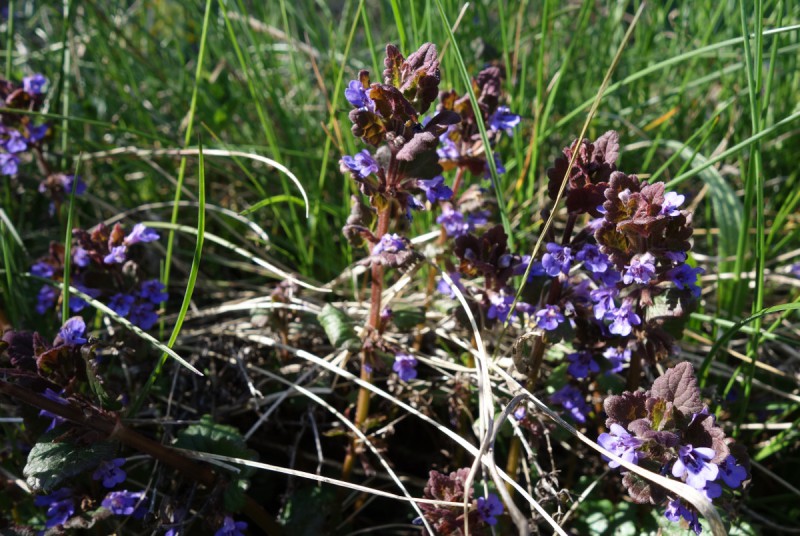Glechoma hederacea L. - syn. Nepeta glechoma Bentham.; Calamintha hederacea Scop.; Nepeta hederacea (L.)Trev. - Lamiaceae
gill-over-the-ground, ground ivy, creeping charlie, field balm, Gill over the ground, Run away Robin, bálsamo-do-campo (port.), Gundermann, Gundelrebe
Perennial creeping herb, up to 40cm high, native to Europe, southwestern Asia, naturalized in North America; stem base purplish; leaves petioled, reniform to reniform-orbicular, sparsely retrorse, coarsely crenate, apex rounded; cymes 2-4-flowered, corolla purple, funnelform, ca.0.7-1cm, upper lip straight, 2-lobed, lower lip obliquely spreading, middle lobe flabellate, lateral lobes ovate. http://www.efloras.org/florataxon.aspx?flora_id=2&taxon_id=200019682
Before the cultivation of hops, this herb was widely used in Europe because of its bitter substances for preserving beer. Because of the bitter substances and essential oils, the plant was also used as a spice. The smell and taste is described as a resinous aromatic, minty and liquorice-like. https://de.wikipedia.org/wiki/Gundermann
The overground parts, collected during flowering were used for healing „pain of the hips“, problems of the liver, and as diuretic.
[Von Gundelreb., Kreutterbuch, Leonhart Fuchs, 1543, Cap.CCCXXXVII]
„Nepeta hederacea is the dried aerial parts of Nepeta hederacea L.Trev. (Fam.Labiatae) a creeping perennial herb common in the British Isles… Contains bitter glechomine, 6-7% tannins, 0.03-0.06% volatile oil and choline… Action: Mild expectorant, anticatarrhanl, astringent, vulnerary, diuretic, stomachic. Indications: Chronis respiratory catarrh, bronchitis, tinnitus aurium, diarrhoea, haemorrhoids, cystitis, gastritis… May be combined with Tussilago, Marrubium, Inula and glycyrrhiza for cough.“
[British Herbal Pharmacopoeia BHP83, Bournemouth. The British Herbal Medicine Association, 1983, 149-150]
Essential oil from Japan contained monoterpene-ketones like (-)-pinocamphone (spicy), (−)-menthone (minty), and (−)-pulegone (minty) as main components.
[Constituents of ground-ivy., Takemoto, T., Kusano, G., Hikino, H., Yakugaku zasshi: Journal of the Pharmaceutical Society of Japan, 86(12), 1966, 1162-1165]
[Hagers Handbuch der Pharmazeutischen Praxis, Springer 2010]
Germacrene D (15.6-18.8%) was the dominant compound in hydrodistilled oils (0.02-0.03%) of G.hederacea collected at full flowering in Lithuania. Other major constituents were γ-elemene (9.7-16.0%), β-elemene (9.8-11.1%), iso-phytol + phytol (4.7-15.6%), (Z)-β-ocimene (4.7-5.6%), germacrene B (2.9-3.9%), β-ylangene (2.7-3.9%), 1,8-cineole (1.9-3.5%). Minor components were α-cadinol (1.1-2.3%), (E,E)-α-farnesene (1.0-1.9%) and β-gurjunene (1.0-2.0%) eg.
[Chemical composition of essential oils of Glechoma hederacea L. growing wild in Vilnius district., Mockutë, D., Bernotienë, G., Judpentiënë, A., Chemistry IJA, 16, 2005, 47-50] http://www.lmaleidykla.lt/publ/0235-7216/2005/3-4/Che_047_050N.pdf
The hydrodistilled essential oil (< 0.05%, v/w, on a dry weight basis) of aerial parts of Glechoma hederacea L. plants, which were transferred from five different natural habitats in Lithuania to the field collection, contained mainly germacrene D (5.5-15.5%), sabinene (6.3-12.3%), 1,8-cineole (5.1-41.6%), β-caryophyllene and caryophyllene oxide (7.3-19.3%,) and γ-elemene (9.6%).
[Chemical composition of the essential oils from Glechoma hederacea plants grown under controlled environmental conditions in Lithuania., Judzentiene, A., Stoncius, A., Budiene, J., Journal of Essential Oil Research, 27(5), 2015, 454-458]

Curtis, William, Flora Londinensis, vol.2 t.44[143] (1777-1778)
http://plantgenera.org/species.php?id_species=467169

Glechoma hederacea, CC BY-SA 3.0, Author: Andreas Kraska